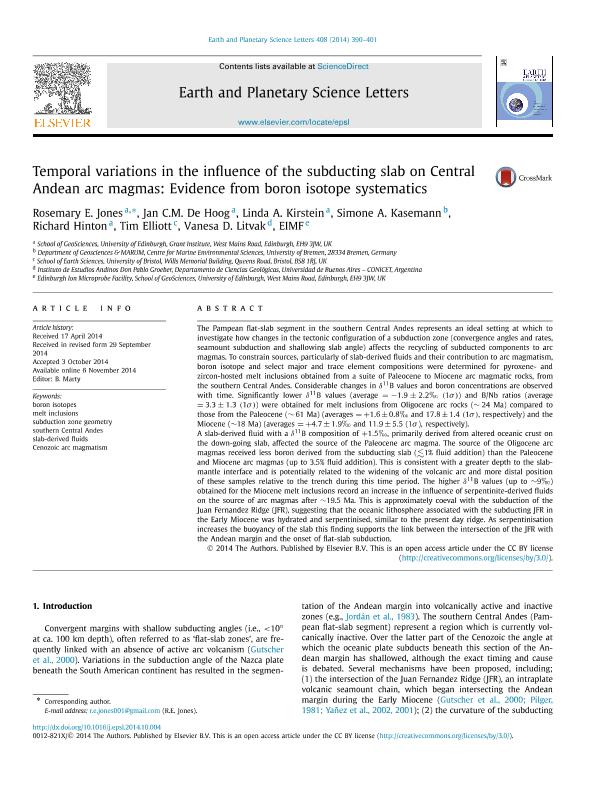Artículo
Temporal variations in the influence of the subducting slab on Central Andean arc magmas: Evidence from boron isotope systematics
Jones, Rosemary E.; de Hoog, Jan C. M.; Kirstein, Linda A.; Kasemann, Simone A.; Hinton, Richard; Elliott, Tim; Litvak, Vanesa Dafne ; Edinburgh Ion Microprobe Facility
; Edinburgh Ion Microprobe Facility
 ; Edinburgh Ion Microprobe Facility
; Edinburgh Ion Microprobe Facility
Fecha de publicación:
12/2014
Editorial:
Elsevier Science
Revista:
Earth And Planetary Science Letters
ISSN:
0012-821X
Idioma:
Inglés
Tipo de recurso:
Artículo publicado
Clasificación temática:
Resumen
The Pampean flat-slab segment in the southern Central Andes represents an ideal setting at which to investigate how changes in the tectonic configuration of a subduction zone (convergence angles and rates, seamount subduction and shallowing slab angle) affects the recycling of subducted components to arc magmas. To constrain sources, particularly of slab-derived fluids and their contribution to arc magmatism, boron isotope and select major and trace element compositions were determined for pyroxene- and zircon-hosted melt inclusions obtained from a suite of Paleocene to Miocene arc magmatic rocks, from the southern Central Andes. Considerable changes in δ11B values and boron concentrations are observed with time. Significantly lower δ11B values (average = −1.9 ± 2.2% (1σ)) and B/Nb ratios (average = 3.3 ± 1.3 (1σ)) were obtained for melt inclusions from Oligocene arc rocks (∼ 24 Ma) compared to those from the Paleocene (∼ 61 Ma) (averages = +1.6 ± 0.8% and 17.8 ± 1.4 (1σ), respectively) and the Miocene (∼18 Ma) (averages = +4.7 ± 1.9% and 11.9 ± 5.5 (1σ), respectively). A slab-derived fluid with a δ11B composition of +1.5%, primarily derived from altered oceanic crust on the down-going slab, affected the source of the Paleocene arc magma. The source of the Oligocene arc magmas received less boron derived from the subducting slab (1% fluid addition) than the Paleocene and Miocene arc magmas (up to 3.5% fluid addition). This is consistent with a greater depth to the slabmantle interface and is potentially related to the widening of the volcanic arc and more distal position of these samples relative to the trench during this time period. The higher δ11B values (up to ∼9%) obtained for the Miocene melt inclusions record an increase in the influence of serpentinite-derived fluids on the source of arc magmas after ∼19.5 Ma. This is approximately coeval with the subduction of the Juan Fernandez Ridge (JFR), suggesting that the oceanic lithosphere associated with the subducting JFR in the Early Miocene was hydrated and serpentinised, similar to the present day ridge. As serpentinisation increases the buoyancy of the slab this finding supports the link between the intersection of the JFR with the Andean margin and the onset of flat-slab subduction.
Palabras clave:
Boron Isotopes
,
Melt Inclusions
,
Subduction Zone
,
Southern Central Andes
Archivos asociados
Licencia
Identificadores
Colecciones
Articulos(IDEAN)
Articulos de INSTITUTO DE ESTUDIOS ANDINOS "DON PABLO GROEBER"
Articulos de INSTITUTO DE ESTUDIOS ANDINOS "DON PABLO GROEBER"
Citación
Jones, Rosemary E.; de Hoog, Jan C. M.; Kirstein, Linda A.; Kasemann, Simone A.; Hinton, Richard; et al.; Temporal variations in the influence of the subducting slab on Central Andean arc magmas: Evidence from boron isotope systematics; Elsevier Science; Earth And Planetary Science Letters; 408; 12-2014; 390-401
Compartir
Altmétricas



